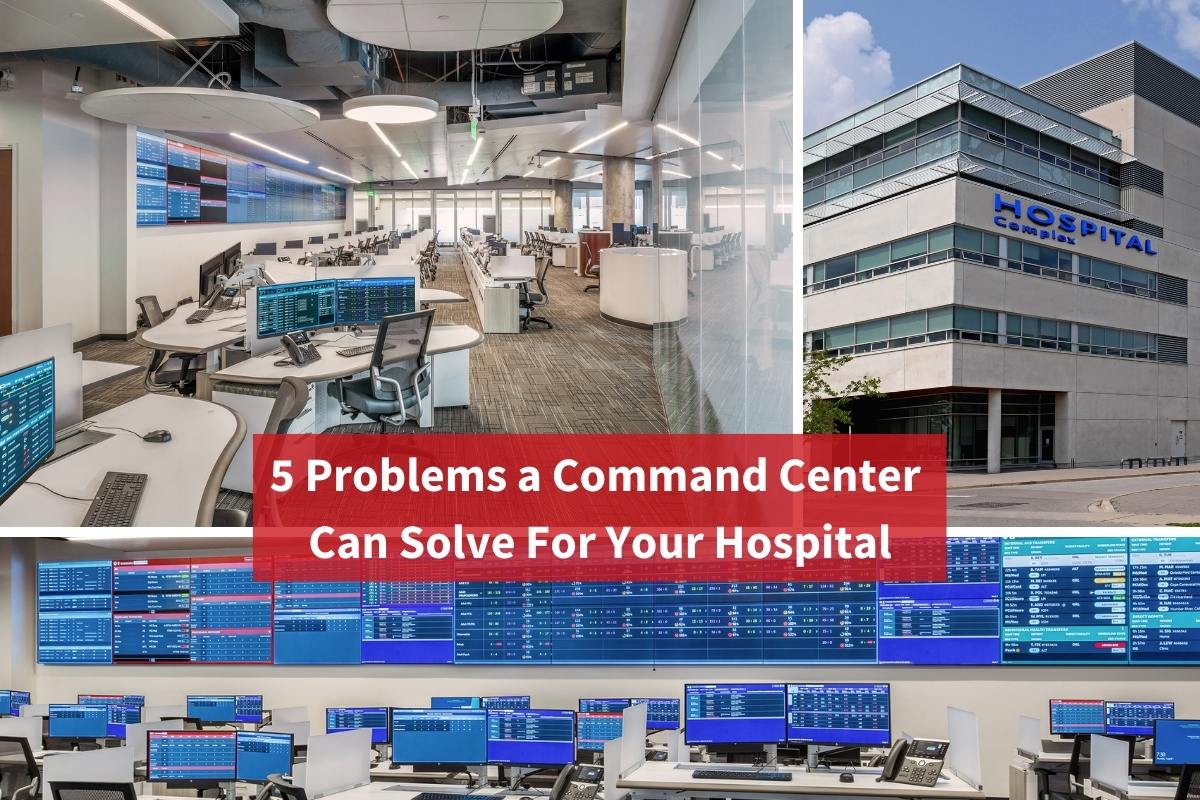Hospitals are beginning to embrace the concept of command centers– centralized rooms with data displayed on video walls, like air traffic control centers or NASA mission control – to manage their operations including patient flow, equipment monitoring and more. Why are these types of rooms taking hold in hospital systems? Why might a command center be a smart choice for your organization?
Creating a centralized hub such as a command center can help your hospital in a number of ways. Here are five problems these centers solve for healthcare institutions.
1. Data monitoring streamlines inconsistent processes and communication
Many hospitals still operate with relatively outdated methods of data tracking. Both the processes and communication across the hospital system are often inconsistent. Within a healthcare environment there’s so much information that can be monitored and used in a centralized hub to improve operations overall.
A command center video wall allows the staff from various departments to see an entire overview of the hospital system’s operations in real time. Routing all the data through a central hub with visualization allows for better communication and faster decision making. This centralized data monitoring improves hospital efficiency and allows operators to spot potential bottlenecks before they occur and take the proper steps to keep things running smoothly.
2. Command centers improve connectivity and standardization
A hospital system is made up of many departments from clinical admissions to transfers and dispatch to financial services. Traditional methods of hospital management can leave these departments disjointed, with inconsistent connectivity and a lack of standardization.
Creating a hospital command center brings these multiple departments together in one place, sharing data that allows for standardization of processes across the entire organization.
3. Centralization fixes sub-optimal bed management
Without an efficient method for oversight, one of the main struggles hospitals face is the efficient management of beds. From inflexible staffing to a lack of transparency to competing priorities, there is a lot to juggle when allocating beds. Centralizing these operations allows for a better view of the entire picture, and the software displayed on the command center video wall can help fill in any gaps in efficient bed management.
Tampa General’s CareComm serves as an example of successful capacity management. CareComm enables the hospital to operate at maximum capacity. As a level one trauma center, Tampa General has reduced emergency room diversion by 25% thanks to CareComm. Altogether, the improvements made by the use of a command center are the equivalent of 30 extra beds of capacity.
4. Mission critical centers break down barriers to optimal patient care
Ultimately the goal of a hospital is to provide the best possible standard of patient care. This can be compromised by a number of challenges including:
- Capacity challenges
- Scheduling difficulties
- Availability of care management
- Barriers to discharge
The increased operational efficiencies enabled through a command center ultimately mean that hospitals are equipped to provide better, more effective care to their patients on a holistic level.
For example, Mission Control at AdventHealth uses artificial intelligence and machine learning to understand patterns and dynamics for better preparation across the board. This results in shorter wait times for patients, improved clinical care, and more efficient transfers and placements.
5. Investing in a command center reduces financial pain points
A command center may seem like an exorbitant investment for your hospital. After all, hospitals often operate on a low margin. However, that low margin means that efficiency is key, and the improved operations due to a command center can quickly translate to monetary benefits.
In a 2018 study by KLAS research , 78% of respondents experienced financial gains after implementing an operational command center. These financial gains were a result of both lower costs as well as better patient retention and referrals due to reduced length of stay or elimination of staffing inefficiencies.
Between its launch in 2018 and late 2020, CareComm at Tampa General saved $40 million due to CareComm’s reduction of system-wide inefficiencies.
Command centers are quickly becoming the gold standard in modern hospitals. As a central hub for data, a command center enables innovative, seamless, and comprehensive patient-centered care while efficiently managing resources.For a project this important, it’s key to select the right partners to guide you through the process. That’s where Constant Technologies comes in. With decades of experience creating mission critical command centers, we offer turnkey services including video wall integration and console workstation furniture. To learn more about how we can help you usher in the next era of patient care, contact us today. Our design and budget consultation is free.
About Constant:
Constant Technologies, Inc. provides AV integration for 24/7 video walls and custom operation center furniture. With 30+ years of experience, we can work with sensitive environments in the public and private sectors. Constant designs and installs projects of all scopes and sizes around in the world. We also offer long-term service and support. We create solutions with the highest levels of security, aesthetics and functionality in mind.


